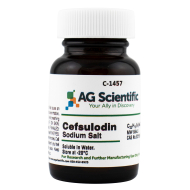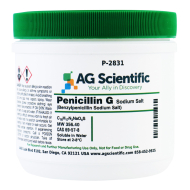The name 'antibiotic' was first given to the drugs that exhibit 'antibiosis' (meaning 'against life'), by Selman Waksman in 1942. After Vincenzo Tiberio discovered a mold (penicillium) in a well that displayed antibacterial, it led others to find the reasoning behind this. However, it was Alexander Fleming's (above) observations of fungus working against bacteria and concluded that it was due to the antibacterial compound, Penicillin.
Discovery of Penicillin
After Italian researcher Vincenzo Tiberio discovered a mold (penicillium) that displayed antibacterial properties in a drinking water well, many researchers were prompted to study the workings of these microbes. The name "antibiotic" was first given to drugs exhibiting antibiosis (meaning "against life") by biochemist and microbiologist, Selman Waksman in 1942. However, it was Alexander Fleming in 1928 who made observations of fungus working against bacteria that led to the conclusion that the activity was due to an antibacterial compound, penicillin. The era of antibacterial antibiotics was opened by a team of researchers led by Gerhard Domagk, who discovered the first sulfonomide, Prontosil, which was the first commercially available antibiotic. Ernst Chain and Howard Florey purified the first penicillin in 1942, which proved potent against a wide range of bacteria while maintaining a low toxicity in human cells. They later shared a Nobel Prize along with Alexander Fleming for the discovery and development of penicillin as a therapeutic drug [1].Mechanism of Action
The first antibiotic discovered, penicillin, was introduced to clinics in time to save tens of thousands of lives from being lost due to infected battlefield wounds in World War II. But how does Penicillin actually work as antimicrobial agent? Back in 1957, a scientist by the name of Joshua Lederberg showed that penicillin kills bacteria by inhibiting the synthesis of their cell walls. His experiments showed that bacteria ordinarily susceptible to penicillin could still be grown in its presence so long as a hypertonic medium was used. A cell's normal molecular physiology dictates they will shrink, but the bacterial organisms Lederberg obtained, called protoplasts, were special because they lacked a cell wall, enabling them to hold form in their hypertonic environments. But, whenever any cells with damaged cell membranes are put into normal growth medium, most will typically die from lysis. From these results, Lederberg deduced that not only were these bacteria completely devoid of a cell wall, but that penicillin was somehow interfering with the bacteria's ability to synthesize a cell wall.
The molecular proof didn't come until 1965, when two biochemists named James Park and Jack Strominger each independantly issued a hypothesis. These jointly formed the first plausible scenario around Lederberg's findings that penicillin is preventing the bacteria from cross-linking the amino acids between polysaccharides during cell wall synthesis. Later that same year, Park and Strominger both observed that bacteria do, in fact, have a unique way to build these cross-links with a mechanism different from ordinary translation. Essentially, they discovered a new enzyme, glycopeptide transpeptidase, which catalyzes the cross-linking reaction in the cell wall of a protozoan. Penicillin inhibits this cross-linking transpeptidase with the Trojan horse strategy. Since penicillin resembles the amino acid D-Alanine used in wall construction, it freely enters through the bacteria's cell wall where it is welcomed into the active site of the transpeptidase enzyme. When penicillin binds, it forms a strong covalent bond with the serine residue at the active site of the enzyme. When the reaction is complete, the transpeptidase enzyme is irreverisbly inhibited and cell-wall synthesis is shut down [2].
Inhibition of Cell Wall Synthesis
All bacteria are encased within an enormous bag-shaped structure known as a peptidoglycan, which provides protection and support. The peptidoglycan layer is formed by two linear chains of polysaccharides; N-acetylglucosamine (NAG) and N-acetylmuramic acid (NAM). These sugars are cross-linked by short peptides. Bacterial enzymes aid the bonds that link one or more polymer chain to another to form the cell wall. Some drugs such as penicillin and cefsulodin bind to specific proteins and cause inhibition of transpeptidase; an enzyme that links the peptidoglycan chain to form a cell wall [3]. The drugs weaken the cell wall so it can no longer provide protection and is subject to lysis or rupture. This mechanism of drug action is the least harmful to human cells since they do not have cell walls. Physiologically, penicillin consists of a thiazolidine ring fused to a B-lactam ring, with an R group attached via peptide bonds [4]. Since the chemical bonds in the arm of the antibiotic are reactive, this relative instability is closely tied to the antibiotic action of penicillin.
Physiologically, penicillin consists of a thiazolidine ring fused to a B-lactam ring, with an R group attached via peptide bonds [4]. Since the chemical bonds in the arm of the antibiotic are reactive, this relative instability is closely tied to the antibiotic action of penicillin.
Allergic Reactions to Penicillin
Penicillin is a small molecule, and by itself does not evoke an immune system response. It can, however, break down and combine with serum proteins in the blood to form a complex molecule known as a hapten, which can illicit an immune response. Most commonly, the reaction produces a rash and fever. The reactions range in severity, but rarely are severe enough to cause death. Penicillin allergies have significant clinical importance to your doctor [5]. Think you might have one? Ask your doctor! Allergic reactions commonly have the following symptoms [6]:- Shortness of breath
- Rash
- Hives
- Itching
- Swelling of the lips, face, or tongue
- Fainting
- You have reduced liver or kidney function.
- You are pregnant
- You are breastfeeding
 Overusing antibiotics is an ongoing problem in the United States. Taking antibiotics if you don't have to can only cause harm. Not only does it disrupt your normal gut flora, it is also a contributing factor to the creation of multidrug-resistant bacteria (aka "super bugs"). Harmless bacteria can develop resistance to multiple antibiotics and cause life-threatening infections. Don't take antibiotics unless you definitely know, meaning that a doctor has told you, that you have a bacterial infection.
Overusing antibiotics is an ongoing problem in the United States. Taking antibiotics if you don't have to can only cause harm. Not only does it disrupt your normal gut flora, it is also a contributing factor to the creation of multidrug-resistant bacteria (aka "super bugs"). Harmless bacteria can develop resistance to multiple antibiotics and cause life-threatening infections. Don't take antibiotics unless you definitely know, meaning that a doctor has told you, that you have a bacterial infection.
Citations
- [1,2] PBS Newshour. The real story behind Penicillin. http://www.pbs.org/newshour/rundown/the-real-story-behind-the-worlds-first-antibiotic/
- [3,4] Biochemistry. by Jeremy M Berg, John L Tymoczko, and Lubert Stryer; W H Freedman, 5th edition, 2002. Page 214-215.
- [5,6] Essentials of Anatomy & Physiology. by Rod R. Seeley, Trent D. Stephens, Philip Tate; McGraw-Hill, 6th edition, Mar 2006. Page 623.


